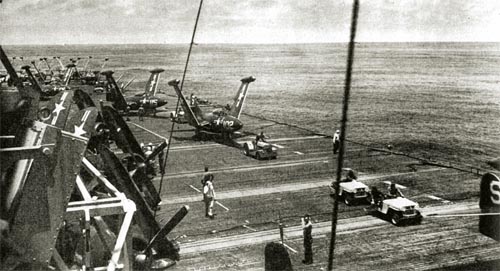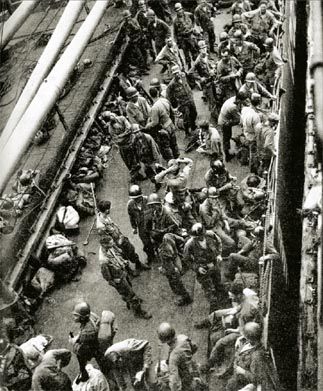HOW THE WAR BEGAN
Onslaught caught South off guard

Before U.S. forces from the American continent could arrive to aid South Korea, the U.S. relied on the employment of heavy air attacks. Above: jet fighters take off from an aircraft carrier. [JoongAng Ilbo]
Looking back now, the Korean War was one South Korea was drawn into without any preparation whatsoever. From the common grunt to the commanders, everyone fought the enemy with determination, but without any proper training or equipment. Thus, the South paid a steep price.
One particular incident that comes to my mind from those tumultuous days occurred when the ROK 1st Division had entered Pyongyang, the very first unit among allied forces to do so, and was engaged in some mopping up duties. Suddenly, an American unit appeared out of nowhere and started to search public buildings in Pyongyang. Members of this unit wore the Indian head insignia belonging to the U.S. 2nd Division. They were members of a special unit that had received direct orders from General MacArthur’s headquarters in Tokyo to collect important enemy documents.
The soldiers of this unit searched every possible public venue in Pyongyang from the lowest district office to Kim Jong-il’s private office in search for clues about the enemy’s plans. One document that was discovered during the search was of utmost importance - a blueprint for the invasion plan of the South. The document had detailed information on the expected harvests in the South, from rice to barley, and the total amount of food the South would be able to produce. What was surprising was that the documents also included information on the production levels of sesame seeds. It just showed how thoroughly the North Koreans had prepared for their invasion of the South.

The Han River Bridge is bombarded by the U.S. Air Force in March 1950. From a U.S. military archive
It is a well-known fact that the South was ill prepared to fight a North Korean Army that had prepared for a very long time.
At a time when the South Korean military had yet to see a tank, North Korea already had a substantial amount of armor ready, while it was also in possession of 122-millimeter guns that could overwhelm anything that the South had in its arsenal. While many of the houses that the North’s citizens lived in were in bad shape, the roads heading South were quite large and in good shape for obvious reasons.
The South Koreans got caught flatfooted at the outbreak of the Korean War, but in the months preceding it, the South Korean military was actually put on alert quite often, anticipating possible provocations. Especially at the beginning of June, the very month the Korean War started, the military was put on alert several times. Ironically, on the 24th, just one day before the outbreak of the Korean War, the general alert was called off and leave was granted to the soldiers and officers alike.
Fate had it that other circumstances at the time worked against the South. In May 1950, Col. Gang Mun-bong, at the time the director of operations at Army Headquarters, had concluded a study in which he compared the military strength of both Koreas. Naturally, the shortcomings of the South Korean military were apparent, but a bill asking the National Assembly to correct the problem was pending in the National Assembly due to provincial elections. In addition, a comprehensive defense plan anticipating a North Korean attack was only devised three months prior to the actual invasion, just further proof of how unprepared Seoul was at the time. That is why the initial North Korean onslaught couldn’t be stopped and the North Koreans were able to push deep into the South.

U.S. soldiers wait at an unknown location to be shipped off to the Korean Peninsula in June 1950. [JoongAng Ilbo]
At the outbreak of the Korean War, when South Korean units were shattered and fled South, General Kim reorganized splintered units and sent them back to the front, buying enough time for forces in the rear to regroup. The time he bought enabled South Korean forces in the rear to gather essential material to send to the front as well.
Under his leadership, the South Korean units delayed the North Korean advance well into July, using the Han River as a general defense line. The general made the best use of the Capital Division, 3rd Division and 8th Division, using them expertly in halting the North Korean forces for a short but very valuable time.
60 years with the military, by Paik Sun-yup
[estyle@joongang.co.kr]










with the Korea JoongAng Daily
To write comments, please log in to one of the accounts.
Standards Board Policy (0/250자)